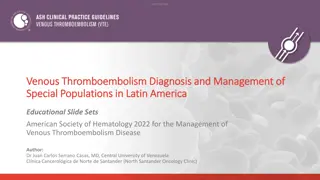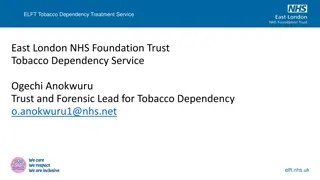Smoking Cessation Service Pathway in Mental Health Inpatient Settings
The NHS Long-Term Plan aims to provide smoking cessation support to all inpatients, including those in mental health settings. The East London NHS Foundation Trust (ELFT) is implementing the Ottawa model to help MH inpatients quit smoking. The ELFT's early implementation pilot focuses on systematic identification of smokers, providing pharmacotherapy and behavioral support, and ensuring community follow-up post-discharge. However, there are gaps in access and engagement with community stop-smoking services. ELFT's efforts are supported by funding and a new smoke-free policy since 2016, including training staff, introducing vapes, and implementing peer support programs.
Download Presentation

Please find below an Image/Link to download the presentation.
The content on the website is provided AS IS for your information and personal use only. It may not be sold, licensed, or shared on other websites without obtaining consent from the author. Download presentation by click this link. If you encounter any issues during the download, it is possible that the publisher has removed the file from their server.
E N D
Presentation Transcript
Smoking cessation service pathway Dr Sally MacVinish Public Health Specialist Registrar & Ogechi Anokwuru Tobacco dependency lead
Overview The NHS Long-Term Plan commits to providing smoking cessation support to all inpatients, including in mental health. ELFT s aim: to increase the proportion of people discharged from MH inpatient setting, who quit smoking (as measured 28 days post discharge) How? Implement Ottawa model by: Systematic identification and documentation of all smokers admitted to a mental health ward; Systematic administration of pharmacotherapy & behavioural support to active smokers admitted; Systematic attachment to appropriate long term community follow-up after discharge: including from both specialist stop-smoking services, and support from CMHTs. Ottawa Model: Universal offer provide support to all admitted patients Support to smokers / e-cigarette users to: Quit smoking Receive continued support following discharge Reduce their harm from tobacco through either: o decreasing the amount they smoke o switching to e-cigarettes ELFT s Early Implementation Pilot: ELFT has been selected as an early implementation site (EIS) to Test and Learn. 140k funding; awarded across Tower Hamlets, Hackney, Newham. Funding and programme cover inpatient smoking cessation support and post-discharge support in community.
ELFT patient data shows high need but gaps in access Very high proportions of ELFT s MH inpatients smoke: ranging between 49% (Bedford MH) and 57% (Newham and Hackney MH) High proportions of ELFT s service users receive very brief advice (VBA) about smoking reduction; smaller proportions receive referrals onwards to local stop smoking services. Variation between directorates suggests there could be room to improve the latter (left hand chart) Once discharged, MH former inpatients are not well engaged/supported by community stop smoking services. Data from Hackney shows that many of those referred by ELFT do not have sufficient contact details to be contacted; and SFH are unable to contact many others. Among those who are contacted, most do accept the service. Cascade diagram: outcomes for those referred to Smoke Free Hackney ELFT referrals vs all general referrals Smoke Free Hackney data via NRS; August 2019-July 2020 Proportions of inpatient smokers receiving VBA; or onward referral ELFT CQUIN data, 2019 Q1 - 2020 Q2 Proportion of all referees who reach each point 100% 100% 100% 100% 97% 95% 90% 90% 80% 80% 79% 77% 74% 70% 70% 65% 60% 60% on pathway 50% 50% 40% 40% 30% 28% 30% 20% 19% 20% 10% 10% 0% 0% Total valid (non duplicate) referrals with sufficient contact details who live in area who SFH managed to contact who accepted service BD CH LT NH TH ELFT Directorate Non-ELFT ELFT Proportion given VBA Proportion referred onwards via NRS
Tobacco addiction service at ELFT Before EIS funding and new model Smokefree policy since 2016 ELFT 3 tobacco advisors Trained staff on Level 2 Pop up clinics Vapes introduced Since EIS funding and new model Multiple programme managers Workstreams Data Recruitment NRT/vapes Peer support
Admission Inpatient Discharge 6 weeks post- discharge ELFT community advisor: 121 + group support in locations that work for local service arrangements and service users TBC (CMHTs, local pharmacies, other ELFT premises, service users homes). Assume 6 sessions per month Community >6 weeks ELFT inpatient advisor: assesses patient + bespoke support. Out of hours, ward staff: initial assessment + brief advice, + NRT /vapes as per below. Smokers are identified via RIO and/or in daily huddle. ELFT inpatient tobacco advisor: full assessment + ongoing bespoke 121 and group support ELFT community tobacco advisor: meets service user and agrees post-discharge support. Assume 6 sessions per month ELFT community tobacco advisor: takes over bespoke 121 + group support, with inpatient tobacco advisor support as required Local authority community tobacco service provide support Tobacco advisors Ongoing access to ELFT/local authority physical health and wellbeing activities and social support Peer support Regular peer support and linking in with ELFT physical health and wellbeing activities and social support Service user meets peer support worker Service user accesses pharmacotherapy from best place for them: primary care, community pharmacy, community stop-smoking service, private purchase, or directly from ELFT community tobacco advisor Pharmaco- therapy NRT +/- e-cigarette available within 2 hours by ward staff or ELFT inpatient tobacco advisor NRT dispensed by ELFT pharmacy Ward staff support the use of e-cigarettes Service user accesses pharmacotherapy as per locally authority stop smoking service local agreement TTA includes 14 days stop smoking medication. NB not all GPs can/will prescribe NRT. ELFT inpatient and community tobacco advisors: coordinate + support service users to access pharmacotherapy Form 1: Life style form: systematic collection of smoking status for all inpatients. Uploaded onto RIO. Filled by admitting clinical staff +/- ELFT inpatient tobacco advisor. Referrals via RIO Form 2: RIO: ELFT inpatient tobacco advisors (currently free text notes) noting needs and interventions provided. Information added for every assessment on Form 2. RIO: discharges + quits RIO: ELFT inpatient tobacco advisor notes accessible and added to by ELFT community tobacco advisor. ELFT advisor RIO notes summarised for community provider at discharge RIO: ELFT inpatient tobacco advisor notes accessible and added to by ELFT community tobacco advisor Referral/transfer made by ELFT tobacco advisor to local authority stop smoking service. Meaningful data/ information is available to community provider Referral/handover from ELFT community advisor to local authority tobacco service Interventions provided and quits documented on local authority system Data & information flow
Challenges Discontinuity of programme manager Vapes Perceptions of harms and benefits Logistics Equity of access Complexity of community pathway COVID-19 Data (PLD)
Enablers QI approach Tobacco dependency advisors in place head start People participation, Peer support workers and apprenticeships Senior buy-in























